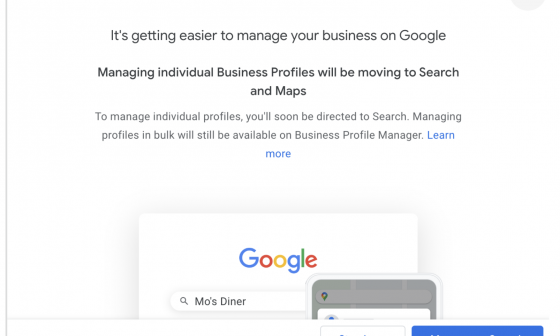In our recent report, we discovered there is a seismic shift in how consumers find business content. Today, customers prefer to find and interact with brands via their digital profiles or local business listings. Therefore, brands need to take action and refocus their online presence and optimize it for the digital-first consumer.
Your digital profiles are an extension of your brand across channels that your customers interact with. Search engines, map apps, social media, voice search, local directories, review and travel apps, etc. all fall into your business’s “digital profile channel”. They provide a platform for you to deliver relevant information about your business that is easily accessible to consumers.
The profile channel is one of the most powerful marketing channels and therefore should demand your team’s attention and monitoring. To help you get started on your journey to profile excellence, we have created an easy checklist for you.
Your checklist for optimizing your Google My Business listings:
#1 Have you updated the name, address, and phone number of your business?
Basic information such as the name of your business, address, and phone number must be up-to-date and consistent across all online directories. Don’t forget to include the zip code. This data is used by search engines like Google to crawl your listing and stamp it as genuine and accurate. Even the slightest variation in detail from one directory to another, such as street number, can result in a penalty and possibly affect the visibility of your listing on search pages.
 Pro tip: Use ‘posts’ to create and share announcements, promotions, popular or new items, in-stock information, or event details, directly with your customers.
Pro tip: Use ‘posts’ to create and share announcements, promotions, popular or new items, in-stock information, or event details, directly with your customers.

#2 Have you set business operating hours?
One of the key parameters you must include in your local business listings are operating hours. This is true for brands that have physical stores and for those who are purely e-commerce/online stores.
Setting operating hours allows you to clearly communicate your availability to buyers and helps in setting the right expectation. For example, if you set your operating hours from 9 am to 5 pm, your shoppers know that you will be unavailable outside those hours.

Let me share a very relevant example — During COVID-19, several grocery stores were allowing seniors to shop at exclusive hours, but only a few updated their listings, which not only led to confusion for shoppers who fell outside the senior age bracket, but it also didn’t communicate to the senior audience that they were offering that service to them.
Pro tip: Update your business hours and publish them across all your listings. This is especially important for stores that have multiple locations in different time zones. In addition, don’t forget to update the operating hours for special days, promotions, and holidays.
#3 Have you added the link to your website?
On average, businesses see 5x more traffic to their digital profiles than. their websites. Adding the link to your website on your digital profile enables customers to connect and engage with your business seamlessly and will drive more visits into your website .
However, in case your business has more than three locations, creating location-based landing pages and linking those to their business listing would be optimal.

#4 Have you added attributes and amenities?
Once you’ve added, optimized, and verified basic information on your local listing such as phone number and address, operating hours, and website, the next step is adding attributes and amenities.
Attributes and amenities help customers understand what you have to offer that is unique to your business. For example, hotels can mention if they offer free Wi-fi or complimentary services. Restaurants can include dietary options such as vegan or gluten-free. Retail can mention if they cater to men, women, children, or all three. They can also include if there is parking available.
When you include relevant and precise attributes in your business listing, you increase the chances of standing out in the search results, for 2 reasons.
- Google is going to associate your attributes to how people search. So if a consumer says “vegan food near me”, you will show for that result.
- Google will reward your profiles for being optimized. The more accurate, optimized, and reviewed your profiles are, the higher you will naturally rank over your competition. You can include other attributes such as photos, menus, promotions, etc. to help you do this.
#5 Did you add photos of your business?
Adding photos to your business’s digital profile can help improve the listing’s performance and boost traffic to your online and offline business. A study revealed that listings with photos received 42% more requests for driving directions on Google Maps than the ones without photos. These listings also saw a 35% increase in click-through rates to websites.
Pro tip: You can feature user-generated images on your business local listing.
#6 Have you included keywords based on customer intent?
Keywords are one of the signals that help search engines understand what your content is all about. Just like optimizing SEO content on websites helps you rank higher on search results pages, adding keywords to business listings can help improve the findability for your business.
Pro tip: Add keywords in your business description and update your business category.
#7 Do you respond to customer reviews regularly?
When customers leave compliments or complaints on your business listing, acknowledge and value their feedback and try to build a relationship. A survey revealed that 92% of people read reviews before making a purchase decision.
As such, online reviews are an invaluable way to strengthen word-of-mouth popularity and persuade new buyers to engage with your business. Synup’s reputation management platform can help you generate 1st party reviews while also helping you manage and respond to the reviews that across all of your digital profile channels.
Pro tip: Respond to all customer reviews including the bad ones to show that you value their insight. Take note that your responses are posted publicly and can be viewed by anyone.
#8 Are your business listings optimized for voice search?
The two most common use cases for voice search currently are: navigational queries and call functions. To optimize your listing for voice search, take a closer look at user intent. Structure your website and content to answer those search queries quickly and efficiently. You can also use voice search SEO tools to improve your chances of your brand being found on search engines.
Pro tip: Use a schema-generator tool to embed FAQs in HTML to your website. This helps search crawlers and voice crawlers better find and process your website’s information.
#9 Are your local business listings optimized for mobile?
Nearly 60% of searches now happen on mobile devices, which means the content you display must be optimized for mobile-first users. To make your website stand out among the search results, you can add posts, videos, invite users to contact you via Business Messages, enable appointment booking, and even include questions and answers
Get more out of your business local listing
A Google study found that “50% of consumers who conducted a local search on their smartphone visited a store within a day.” Meaning, if you have a product or service to offer, you must invest a considerable amount of time in optimizing your digital profile.
Does this mean you have to manually check your digital profiles and find the gaps and discrepancies if any?
Absolutely not!
Automate your digital profile experiences with Synup. You can bulk add all of your locations, customize your displayed media, and manage your brand’s online reputation seamlessly in one dashboard. Don’t just check the boxes on this list. Turn your profiles into your strongest growth channel.


